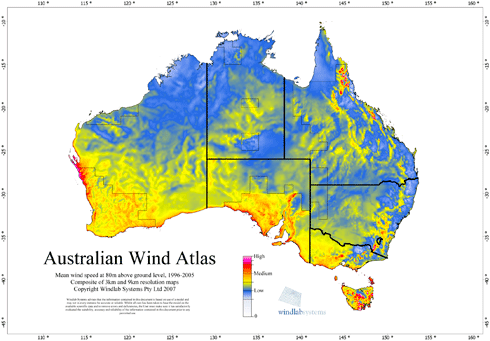ECOS Magazine has a look at a company trying to gain an edge in wind farm development using sophisticated mapping techniques to identify optimal wind generation locations - Good prospects for local wind-mapping company.
When Queensland recently announced the construction of a 720?kilometre high-voltage transmission link between Townsville and Mount Isa, it opened a door for Australian-based company Windlab Systems to advance the development of the country’s largest wind farm – a 750 megawatt facility near Hughenden, southwest of Townsville.
It’s a major coup for the company, which began when CSIRO scientists Dr Keith Ayotte and Dr Nathan Steggel headed up a spinoff to commercialise a CSIRO wind modelling and mapping program.
Their WindScape program determines a site’s wind resource potential by generating high-resolution maps from existing meteorological data of mean annual wind speed and annual energy yield for target sites. Dr Ayotte describes it as a remote ‘prospecting’ tool for initial assessment of site viability without the need for field measurements.
However, good wind conditions don’t guarantee a successful wind farm. The program’s wind information is therefore combined with powerline and land?use data to assess proximity of grid connections and land?use types in the vicinity. This integration of data reduces risk by shortening development timeframes. It also increases the likelihood of selected sites leading to commercially viable projects that address local community and environmental concerns.
The wind-mapping program is complemented by a turbulence-flow modelling program, which ensures turbine longevity through minimising operations and maintenance costs.
Today, Windlab has evolved from a wind-mapping consultancy to a wind-farm developer that uses its mapping and modelling technologies to identify large-scale projects and take them from concept to financial close. ...
Dr Ayotte, now Windlab’s Chief Technology Officer, says one of the biggest constraints in Australia is the sparse electricity grid.
‘You tend to find yourself scratching around for places that are windy and near the grid,’ he says. ‘We have the advantage, because we can really burrow down into the data to find less obvious locations.’
Collgar Wind Farm in Western Australia, Oaklands Hill in Victoria and Coopers Gap in southern Queensland are all examples of ‘less obvious’ inland locations identified through WindScape.
Once a grid connection point is identified, the next constraint is the high cost of connecting to the transmission line.
‘That can kill the economics of your wind farm, unless it is big enough that you can spread the cost among a lot of turbines,’ says Dr Ayotte. Windlab focuses on large-scale wind farms, from 100–200 megawatt capacity and upwards. ...
Despite this uncertainty, the prospects for Windlab look good. Its projects in Australia and South Africa are multiplying, and Queensland’s proposed $1.5 billion Kennedy wind farm project – an installation of up to 300 turbines – is set to create 1000 jobs and boost Queensland’s power generation capacity by six per cent.

No comments:
Post a Comment